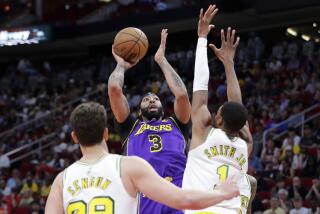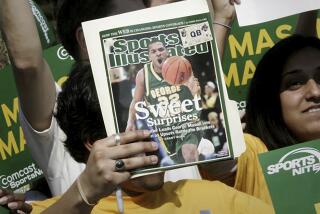Magazine Subscription Pitches Throw a Curve
- Share via
Magazine subscription promotions are coming thick and fast, all apparently offering different rates. But which is better: $1.09 an issue of Sports Illustrated for 54 weeks (“50% Savings”) or 22 issues for four payments of $5.99 each (“$32.80 Off”)?
Who knows? “I took a six-month deal from Time, 50% off,” one consumer says, “but now that you ask, I have no idea whether it was a good deal or not.” It’s a valid question.
For many magazines, subscriptions mean stability, a paid-in-advance customer base. Few can specialize in newsstand sales, catching impulse buyers with sex or celebrities. People, for example, is 65% newsstand-sold; news magazines such as Time are barely 5%. “You can’t ask all magazines to deliver on the newsstand every month,” says Life’s managing editor, Judith Daniels. “Life might have a celebrity cover one month, but not all 12.”
Individually, subscription sales are less profitable. The magazine may sell for half of its newsstand price and must be mailed, and it’s costly to woo new subscribers through advertising or direct mail. Still, the sales volume from such promotions can justify the thinner margin.
Magazines particularly want subscription sales now. For one thing, there’s more competition for customers; there were 1,200 domestic consumer magazines in 1980 and 1,492 in 1985, almost 25% growth.
For another, publishers need subscriptions to make up for slipping newsstand sales. Some blame a decline in corner stores and newsstands, some the competition of videotape rental, and some today’s newsstand prices. “The years 1980-85 saw the greatest growth in cover prices since 1960,” says David Lee, vice president of the Magazine Publishers Assn. in New York, “with prices rising 40% during an essentially non-inflationary period.”
Price Seems Secondary
The current mail deluge is also seasonal. January is boom time for direct mail promotions of all kinds, given both “the start of a new year and the continuation of a spending mood,” Lee surmises.
The biggest pitch is to prospective new subscribers, perhaps unfamiliar with the magazine. It seems assumed they won’t be interested either: Product and price often seem secondary to premiums and prizes--digital watches, digital clocks, phones, cameras, shower radios and binoculars. Readers Digest-type sweepstakes are also big now, offering cars, vacations, second homes, personal computers and plain cash. Says Jake Weinbaum, vice president of circulation at U.S. News & World Report in Washington, “You’ll be lucky if you find the magazine mentioned in the offer.”
Such promotions bring in subscribers, but not perhaps the best prospects for renewals. “People buy the premium, not the magazine,” says Steven Florio, publisher of the New Yorker, which is increasing new subscribers through its first direct mail promotion since 1971 but doesn’t want to jeopardize its 75% renewal rate. U.S. News’ current campaign also emphasizes the magazine’s content: Clearly, Weinbaum says, there’s more chance of keeping a subscriber “if someone signs up based on interest in the magazine itself.”
Cut-rate offers may ultimately cause publishers the same problem. The problem they give consumers is more immediate: Who can tell the price? Worse, who can tell if it’s low?
Many offers don’t even mention the total amount to be billed, making consumers figure out what they’ll pay for 52 issues at 97 cents apiece. Some deserve close reading: The New Yorker offers “three free issues” with an option of 49 more for “just $32,” but those three are free only if one rejects the special option and reorders at the usual rate of 52 issues for $32.
Paid Same Amount
Calculators (alas, rarely premiums) are required. What’s the advantage over regular subscriptions in Time’s offer of six months at 97 cents an issue (“Save 50% Off”), or even three years at 89 cents an issue (“Save 54% Off”)? Should one order those 22 issues of Sports Illustrated from Publishers Clearing House for four $5.99 payments, or 54 issues direct from Sports Illustrated for $1.09 apiece? The 27 issues of Newsweek for four payments of $4.96, or 52 issues for $39 from Newsweek itself?
It hardly matters. Time’s cuts came off newsstand price; consumers who sprang for six months saved only 2%, or $1.04, off a regular subscription, and for three years would have “saved” $1.73 a year and tied up $139. And at any given time, most offers to “the general public” are essentially the same. Anyone who took up Publishers Clearing House on Sports Illustrated or Newsweek paid the same as people who ordered direct-- $58.86 for a year of SI, about $39 for Newsweek.
There are exceptions, however, for special segments of that public--students and educators, “professionals” or businesses with “reception areas.” These pay as little as half of regular subscription rates.
Understanding the game, almost anyone can play: Many households have potential special subscribers, most likely students. Failing that, consumers can at least save on playtime. “I don’t jump at those offers,” one woman says. “I just collect them and decide later if one’s even marginally better. Sometimes I let them lapse: The best are for new subscribers, if only because of the free clock.”


